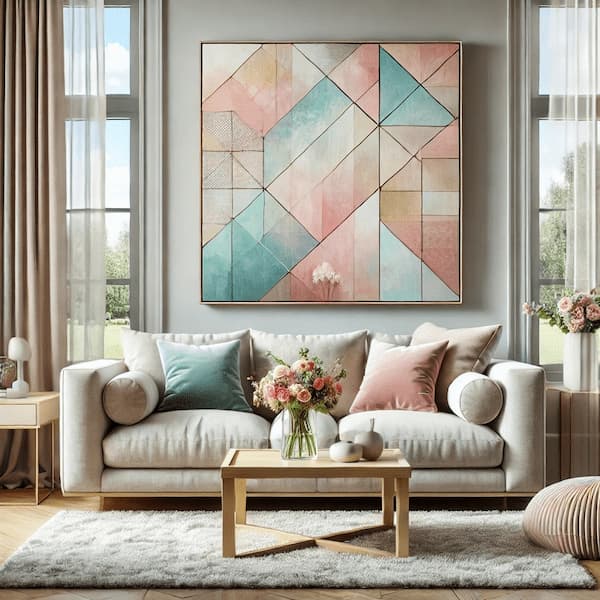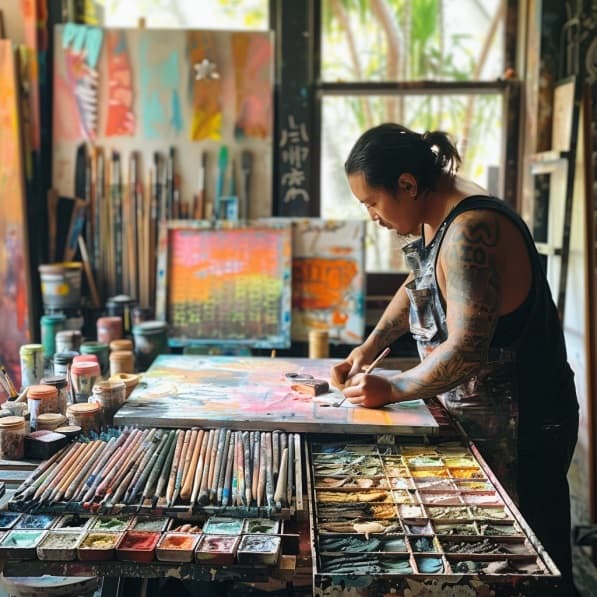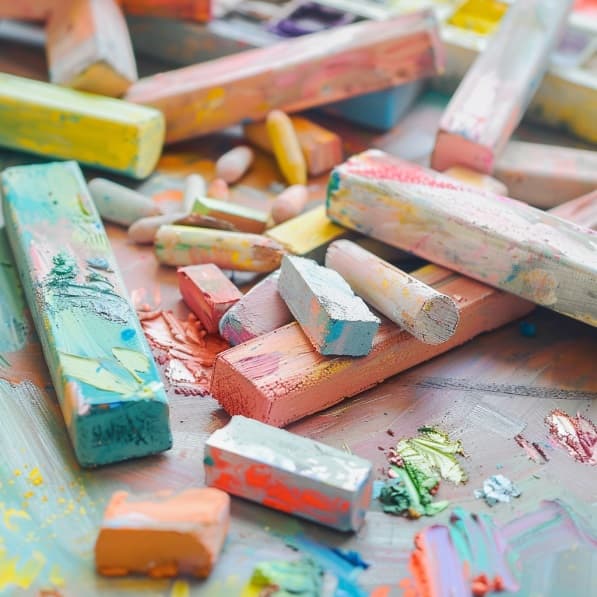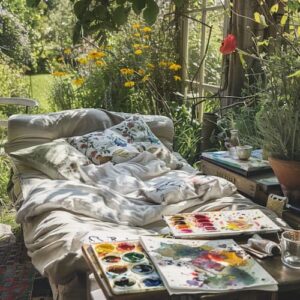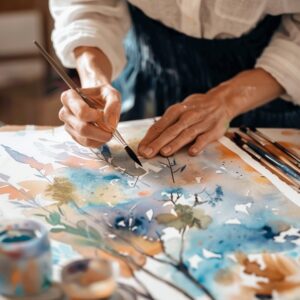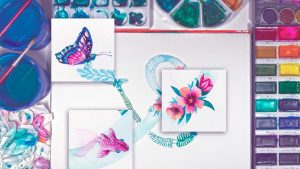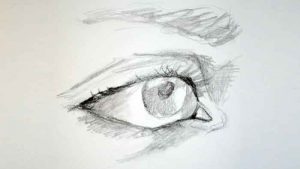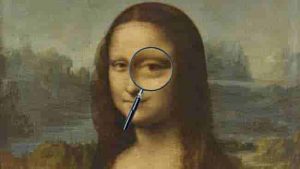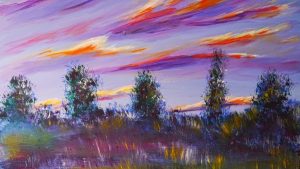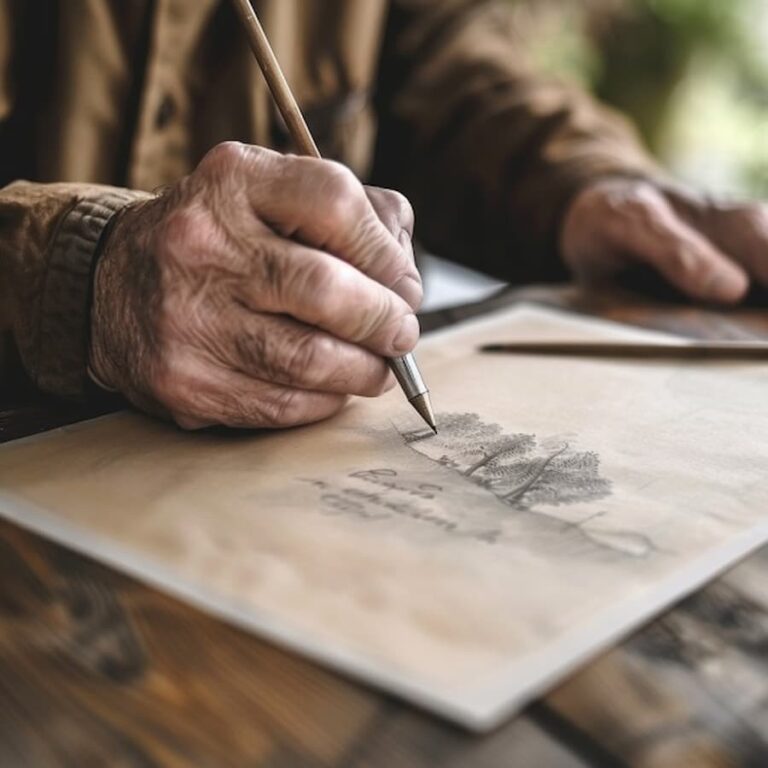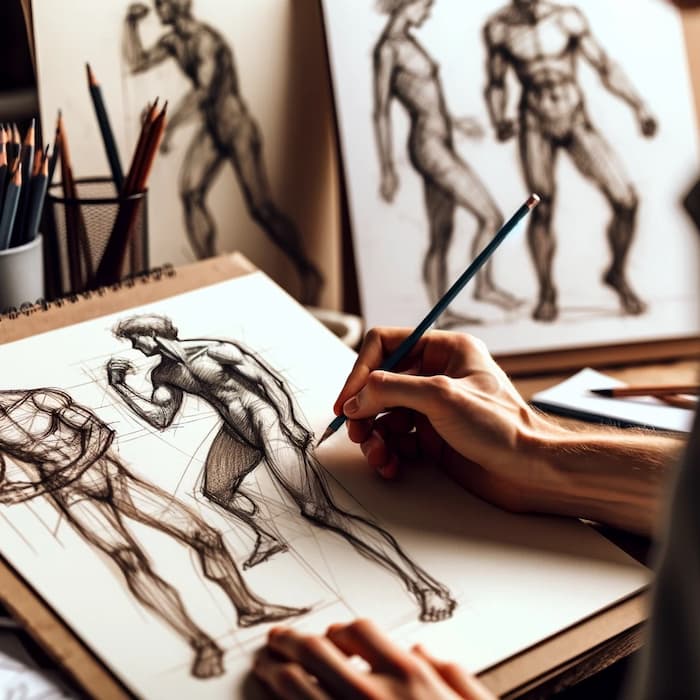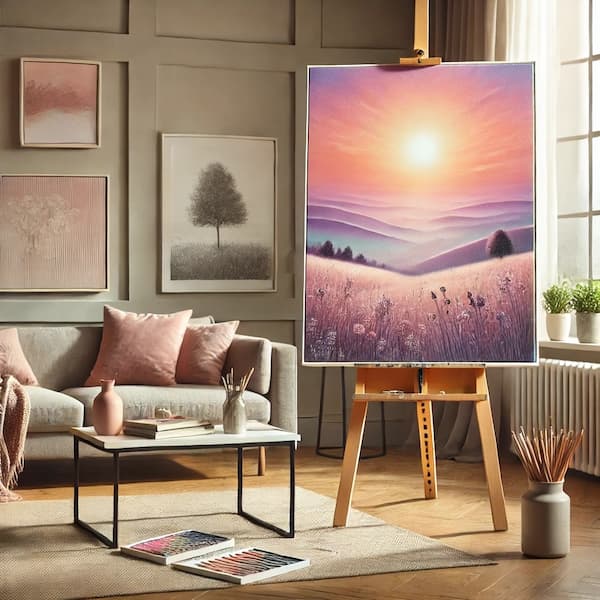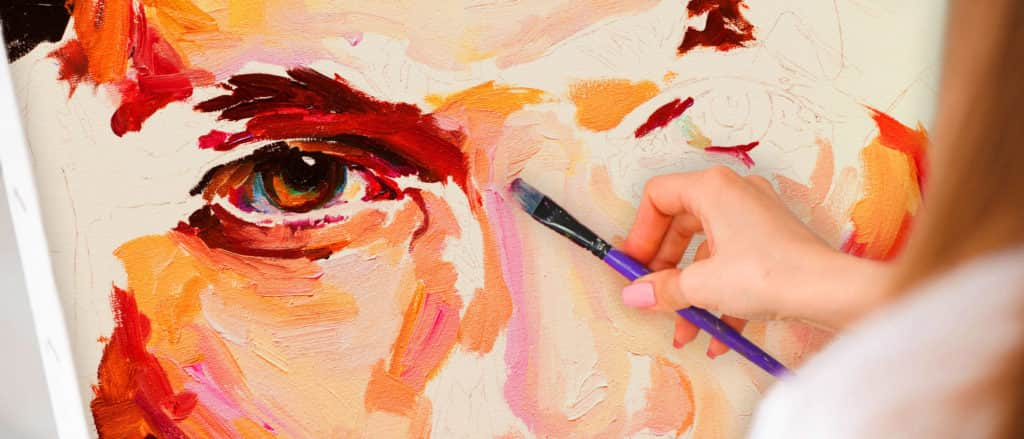Pastel painting is one of the most versatile and expressive artistic techniques.
In this article, we will explore the basics of pastel painting, from the choice of materials to the essential techniques for mastering this art.
Introduction to Pastel Painting
Pastels, known for their vibrant range of colors and textures, offer a unique experience for artists.
Unlike other mediums such as oil or watercolor, pastel combines the qualities of drawing and painting in a compact and accessible form.
But what makes pastel so special?
What are Pasteles?
Pastels are sticks of dry pigment that are mixed with a binder to hold their shape.
There are three main types of pastels:
- Dry Pastels: Include soft and hard pastels.
They are ideal for a wide range of techniques due to their ability to blend and blend easily. - Oil Pastels: Contain oils that give them a creamy texture.
They are perfect for thicker and layered effects. - Pastels in Bars: Combine characteristics of dry pastels and oil pastels, offering a balance between fluidity and texture.
Basic Principles of Pastel Painting
The first step in painting with pastels is to understand how the different types of pastels work and how they can be applied to various surfaces.
Materials Needed and Choice of Cakes
- Soft Pastels: They offer a wide variety of vibrant colors and are easy to blend.
However, their soft texture can be a challenge for beginners. - Hard Pastels: They are ideal for details and fine lines due to their firmer consistency.
- Oil Pastels: Provide a more robust finish and are excellent for layering and texturing.
Papers and Supports
The choice of paper is crucial to the success of a pastel painting.
Textured papers allow for better pigment adhesion.
Some of the most recommended include:
- Canson Mi-Teintes paper: Popular for its texture and variety of colors.
- Sand Paper: Offers a rougher texture, ideal for retaining several layers of cake.
- Pastelmat paper: Combines smoothness and texture, providing a unique surface to work on.
Other Materials
- Fixative: Used to fix the pastel and prevent stains.
- Diffusers or Tortillones: Tools for blurring and mixing colors.
- Gloves and Mask: To protect from cake dust.
Pastel Painting Techniques
Once you have your materials, it’s time to explore basic pastel painting techniques.
- Blurring Technique: Blurring is essential for creating smooth transitions and gradient effects.
You can blend with your fingers, a soft cloth, or a blender.
The key is to apply the pastel in light layers and blend to the desired softness. - Layering: The layering technique allows for depth and texture.
Start with lighter colors and work toward darker colors, applying each layer gently to avoid saturating the paper. - Texture Effects: To create texture, you can use techniques such as scratching or rubbing.
Scratching involves scraping off the top layer of pastel to reveal the color underneath.
Rubbing uses tools such as stiff brushes or spatulas to create patterns on the surface. - Color Blending: Color blending in pastels can be achieved in several ways.
One of the most common is to overlap layers of different colors and blend them.
You can also mix directly on the palette before applying to the paper.
Care and Conservation
Caring for your paints and materials is crucial to maintain their quality over time.
- Fixing the Work: Applying a fixative at the end of your work helps protect the pastel from smudging and wear.
Use spray fixatives in a well-ventilated area and with light coats to prevent colors from bleeding. - Storage: Store your paints in protective folders or frames with glass to avoid direct contact with the surface.
Upright storage is ideal to prevent pastel dust from accumulating. - Material Maintenance: Keep your cakes organized and clean.
You can use a box with compartments and a soft cloth to wipe off dust residue.
Tips and Tricks for Beginners
-Practice Light Hand
Light pressure when applying the pastel allows for smoother layers and better blending possibilities.
Avoid pressing too hard, as this can saturate the paper and make correction difficult.
-Experiment with Textures
Don’t limit yourself to using only your fingers to blend.
Try different tools such as brushes, sponges, and blenders to see how they affect the texture and appearance of the cake.
-Use Color Strategically
Choose complementary colors to create contrast and analogous colors for smooth transitions.
Experiment with color combinations to discover new palettes.
-Learn from the Masters
Look at works by well-known artists who use pastel for inspiration and to learn new techniques.
Looking at how they handle light, color, and texture can offer valuable insights.
-Keep your work area clean.
Cake dust can be harmful if inhaled in large quantities.
Be sure to work in a well-ventilated area and regularly clean your workspace.
Pastel painting offers an exciting opportunity to explore color and texture in a direct and tactile way.
With these basic principles, you’ll be well on your way to mastering this technique and creating vibrant, dynamic works of art.
To learn how to work with pastels like a real professional, knowing all its characteristics, use of materials and how to get the most out of this technique, visit our Painting Course with Lifetime Access + Workshops.
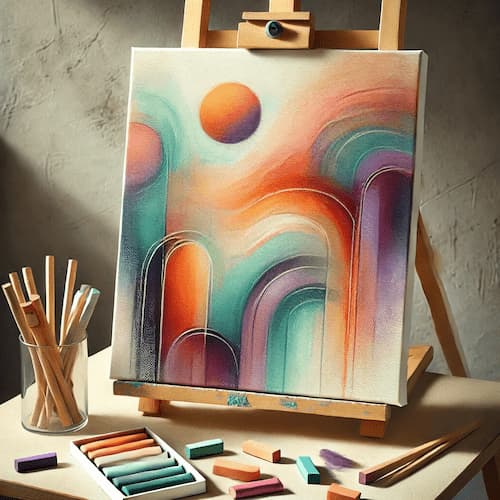
Técnicas Utilizadas en los Cuadros a Pastel Modernos
Técnica de Superposición en los Cuadros a Pastel Modernos
Una de las técnicas más empleadas en los cuadros a pastel modernos es la superposición de capas. Esta técnica consiste en aplicar colores capa sobre capa para conseguir una mayor profundidad y volumen en la obra. La versatilidad de los pasteles permite a los artistas jugar con las transparencias y opacidades, creando efectos visuales únicos.
Uso del Borrado en los Cuadros a Pastel Modernos
Otro recurso común es el uso del borrado. Esta técnica permite difuminar los bordes de las formas o crear suaves transiciones de color, lo que es especialmente útil en los cuadros modernos en tonos pastel, donde las gradaciones sutiles juegan un papel esencial. Esta herramienta es crucial para suavizar los contornos o eliminar capas de color que no sean necesarias, creando un acabado más limpio y preciso.
¿Cómo Integrar Cuadros a Pastel Modernos en la Decoración de Interiores?
Los Cuadros Modernos en Tonos Pastel como Elementos Decorativos
Los cuadros modernos en tonos pastel son ideales para complementar cualquier tipo de espacio. Estos cuadros se adaptan especialmente bien a ambientes minimalistas y contemporáneos debido a su suavidad y sutileza visual. La paleta de colores pastel no solo añade un toque de modernidad, sino también de serenidad y elegancia.
Al incorporar cuadros a pastel modernos en la decoración, es importante tener en cuenta el equilibrio entre la obra de arte y el entorno. Los tonos suaves ayudan a equilibrar espacios con muebles o decoraciones más llamativas, creando una armonía visual.
Consejos para Colgar Cuadros a Pastel Modernos
Para aprovechar al máximo el impacto de los cuadros a pastel modernos en tu hogar o lugar de trabajo, sigue estos consejos:
- Altura adecuada: Asegúrate de colgar los cuadros a la altura de los ojos para que puedan apreciarse completamente.
- Iluminación: Una correcta iluminación resaltará las texturas y los colores de los pasteles, creando un efecto visual más potente.
- Marcos sencillos: Debido a que los pasteles ya tienen una riqueza visual, opta por marcos simples que no compitan con la obra.
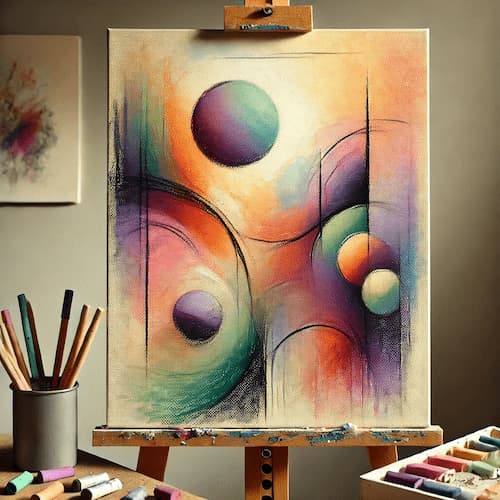
Los Mejores Artistas de Cuadros a Pastel Modernos
Artistas Reconocidos en el Mundo de los Cuadros a Pastel Modernos
Hoy en día, muchos artistas destacan por su uso innovador de los pasteles. A continuación, algunos de los nombres más reconocidos en este ámbito:
- Casey Klahn: Este artista contemporáneo es conocido por su uso audaz del color y su enfoque abstracto en los cuadros a pastel modernos.
- Debora Stewart: Especializada en arte abstracto, utiliza tonos suaves para crear composiciones armónicas que se alinean con las tendencias actuales de los cuadros modernos en tonos pastel.
- Jacob Aguiar: Sus paisajes minimalistas y vibrantes son un excelente ejemplo de cómo los pasteles pueden usarse para capturar la luz y la atmósfera de manera única.
Cómo Inspirarse en los Cuadros a Pastel Modernos
Si estás buscando inspiración para crear tus propios cuadros a pastel modernos, puedes comenzar observando el trabajo de estos artistas contemporáneos. Su capacidad para combinar tradición y modernidad en el uso de los pasteles es una excelente fuente de ideas.
Los cuadros a pastel modernos ofrecen una ventana a la expresión contemporánea del arte, fusionando técnicas clásicas con estilos actuales. Desde los colores vibrantes y la textura rica hasta los cuadros modernos en tonos pastel que decoran los hogares de todo el mundo, esta técnica sigue siendo una de las preferidas por los artistas y los amantes del arte. Ya sea que busques inspiración o quieras adquirir una obra, los cuadros a pastel modernos son una excelente elección para aportar personalidad y estilo a cualquier espacio.
Para aprender a trabajar con pastel como un auténtico profesional, conociendo todas sus características, uso de materiales y cómo sacarle el máximo partido a esta técnica, visita nuestro Curso de Pintura con Acceso Vitalicio + Talleres.

